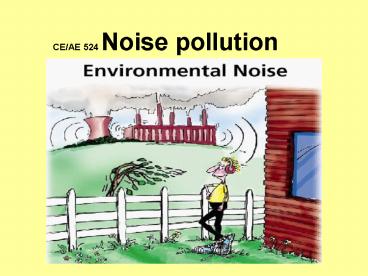CEAE 524 Noise pollution - PowerPoint PPT Presentation
1 / 26
Title:
CEAE 524 Noise pollution
Description:
CE/AE 524 Noise pollution. CE/AE 524 Noise sources. Sound propagation. How ... E.g. Implications of the decibel scale: ... Snow mobiles. Industry. Davis and ... – PowerPoint PPT presentation
Number of Views:652
Avg rating:3.0/5.0
Title: CEAE 524 Noise pollution
1
CE/AE 524 Noise pollution
2
CE/AE 524 Noise sources
3
Sound propagation
4
How sound is measured
- Pressure, P, usually Pascals
- Frequency, f, usually Hertz
- Intensity, I, usually W/m2
- Bels, L, derived from logarithmic ratio
- Decibels, L, derived from bels
P 1/f I W/A L log (Q/Qo) L 10log
(Q/Qo)
E.g. Implications of the decibel scale doubling
sound level would mean that the sound will
increase by 10log2 3dB Ten times the sound
level 10log10 10dB
5
Adding decibels and subtracting background noise
6
Chart method adding decibels
7
dBA, dBB, dBC scales
8
Weighting factors
9
Chart method subtracting background noise
10
Sound and Human Hearing
People generally hear sounds between the
threshold of hearing and the threshold of
pain In terms of pressure, this is 20 µPa
100 Pa The decibel scale was developed from this
fact and makes numbers more manageable. The
decibel scale generally ranges from approximately
0 to 130.
11
How Sound is Heard
12
Human hearing and Frequency
13
Frequency and pitch
14
Human voice pitch
- Sound is produced when aerodynamic phenomena
cause vocal folds to vibrate rapidly in a
sequence of vibratory cycles with a speed of
about - 110 cycles per second or Hz (men)
- 180 to 220 Hz (women)
- 300 Hz (children) higher pitch
- The speed of sound in gas is proportional to the
square root of its density. Sound travels at 343
m/s in air at 20C. 2.7 times faster in helium.
15
Typical Voice Ranges
Soprano C4-C6
Alto G3-F5
Tenor D3-A4
Bass E2-D4
16
Sound and Human Hearing - Frequency
Humans are less sensitive to low frequency sound
and more sensitive to high frequency sound.
Therefore, sometimes the dB scale is adjusted to
take this into account A-weighting (db(A))
adjusts overall scale so it better matches what
the human ear would hear C-weighting (dB(C))
adjusts scale for loud or low frequency
sounds B-weighting (dB(B)) adjusts by factors
that are in between the A-weighted factors and
C-weighted factors (rarely used)
17
The filters used for dBA and dBC
The most widely used sound level filter is the A
scale, which roughly corresponds to the inverse
of the 40 dB (at 1 kHz) equal-loudness curve.
The sound level meter is thus less sensitive to
very high and very low frequencies. Measurements
made on this scale are expressed as dBA. The C
scale (in dBC) is practically linear over several
octaves and is thus suitable for subjective
measurements only for very high sound levels.
18
Loudness in phons
- The phon is related to dB by the
psychophysically measured frequency response.
Phons dB at 1 kHz. For other frequencies, the
phon scale is determined by loudness experience
by humans.
19
Loudness in sones
- The sone is derived from psychophysical tests
where humans judge sounds to be twice as loud.
This relates perceived loudness to phons. A sone
is 40 phons. A 10 dB increase in sound level
corresponds to a perceived doubling of loudness.
So that approximation is used in the definition
of the phon 0.5 sone 30 phon, 1 sone
40 phon, 2 sone 50 phon, 4 sone 60 phon, etc.
20
Other descriptors of sound
Equivalent sound level the level of sound that
has the same acoustical energy as does a
time-varying sound over a stated time
period. Percentile sound level the sound level
exceeded n percent of the observation time
interval. Day-night average sound level the
equivalent sound level for a 24-hour period that
incorporates a decibel penalty during night hours.
21
(No Transcript)
22
Typical suburban sound and their levels
23
(No Transcript)
24
Major transportation sources of noise pollution
rail, road, and air
25
Other sources of noise pollution that need to be
addressed
- Boat noise,
- especially jet skis
- Construction noise
- Snow mobiles
- Industry
26
References
Davis and Cornwall, Chapter 7 Brüel Kjær Sound
Vibration Measurement A/S Steve J. Gent, P.E.,
Research Coordinator, Iowa Department of
Transportation FHWA































